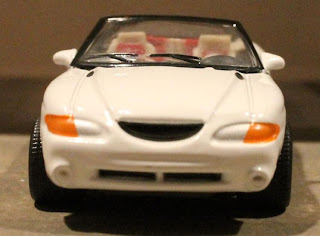A blog focusing on 1/64 diecast from such popular brands as Hot Wheels, Matchbox, Johnny Lightning, M2 Machines, GreenLight, Tomica, Yat Ming, Majorette, MotorMax, Siku, Corgi, Guisval, Playart, Ertl, Zylmex, Racing Champions, & many more. Swifty's Garage features a daily Car Of The Day and news updates from your favorite brands!
Wednesday, October 3, 2012
Car Of The Day: October 3, 2012
Today's car of the day is Matchbox Premiere's 1994 Ford Mustang Cobra.
For 1994, the Mustang underwent its first major redesign in fifteen years. The design, code named "SN-95" by Ford, was based on an updated version of the Fox platform. It featured dramatic new styling by Patrick Schiavone that incorporated some stylistic elements similar to those of earlier Mustangs. A convertible model would also return, but the notchback and hatchback body styles used in earlier Mustangs were not available. Prior to the redesigned Mustang's launch, a 2-seater concept car called the Mustang Mach III was shown at the 1993 North American International Auto Show in Detroit and hinted at what future Mustangs might look like. The production Mustang resembled the Mach III concept's sweeping body curves. The Mach III concept also featured a supercharged 4.6 L DOHC V8 with 450 hp (336 kW; 456 PS). While this engine was not put into production, it hinted to the future use of Ford's Modular V8 in the Mustang, including the eventual use of a supercharged 4.6 L V8.
For more information and pictures of the real car please visit: Ford Mustang
This casting is actually the Indy 500 pace car recolored. The rollbar is what gives it away. This casting is still available and was most recently an exclusive model in ten packs. Not bad for a model approaching classic status at this point. Quite possibly the nicest '94-'98 Mustang in small scale.
The base Mustang featured a 3.8 L OHV V6 mated to a standard 5-speed manual transmission or an optional AODE 4-speed automatic transmission. The V6 produced 145 hp (108 kW; 147 PS) at 4000 rpm and 215 lb·ft (292 N·m) of torque at 2500 rpm. For 1996, the base V6 gained five horsepower with a new powertrain control module (PCM), the EEC-V. The AODE transmission was replaced with the 4R70W 4-speed automatic transmission for 1996.
Ford allocated $700 million to improve the Fox platform for the 1994 Mustang. Efforts were made to improve the car's handling as well as noise, vibration, and harshness (NVH) conditions over the previous generation Mustang. The Mustang's front suspension makes use of MacPherson struts with longer lower control arms, new spindles, anti-roll bars, and other enhancements over 1993 and older Mustangs. In the rear, a four-bar link solid axle is used. The 1994 Mustang's standard rear axle ratio was 2.73:1, though this was later changed to 3.27:1. All Mustangs received standard four-wheel disc brakes, though anti-lock brakes (ABS) were optional.
Along with its new exterior, the 1994 Mustang received new interior styling. The Mustang's cabin featured a "dual-cockpit" layout that was adorned with contours and sweeping curves, similarly to other Fords of the time such as the Thunderbird. The 1994 Mustang offered many amenities and conveniences, a number of which later became standard equipment. The preferred equipment package came with power windows, mirrors, and door locks, remote keyless entry, air conditioning, cruise control, and a trunk cargo net. Also available was Ford's Mach 460, 230-watt multi-speaker sound system with CD player. All 1994 Mustangs received standard three-point seat belts and dual front airbags. Also, in 1996, the Mustang's tail light design changed from three smaller horizontal strips to three larger, contiguous vertical strips.
Building on the base Mustang, the Mustang GT was reintroduced for 1994, featuring higher performance and better handling than the base Mustang or its 1993 predecessor. Ford carried over the 302 CID Windsor pushrod small-block V8 engine (called the "5.0 L" although its capacity was 4.94 L) from the 1993 Mustang GT. Total output from the engine was 215 hp (160 kW; 218 PS) at 4200 rpm and 285 lb·ft (386 N·m) of torque at 3500 rpm. Though more refined, the 5.0 L V8 actually saw a drop in output for 1994 from the 1993 model year due to stricter emissions control (although many dyno figures do not support Ford's drop in power rating). Mustang GTs could deliver zero to 60 mph (97 km/h) acceleration times in the mid-six second range and complete a quarter mile in about 15 seconds. The Mustang GT also featured a stiffer handling suspension, a 3.08:1 rear axle ratio (later changed to 3.27:1 or 3.55:1 depending on the transmission and model year), dual exhausts, and larger 16-inch (410 mm) wheels (compared to the base Mustang's 15-inchers). The 1994 Mustang GT was named Motor Trend Car of the Year.
For 1995, a one-year model referred to as the Mustang GTS was introduced. This was considered to be a "stripped down" version of the Mustang GT that included the performance parts of the GT model, but a minimum of non-performance related features.
Ford dropped the 302 CID Windsor V8 that was in production since 1968, and the 1996 model year introduced the Modular 4.6 L SOHC V8. The new engine produced 215 hp (160 kW; 218 PS) at 4400 rpm and 285 lb·ft (386 N·m) of torque at 3500 rpm, matching the output of its predecessor. For 1998, the 4.6 L V8 received a small increase in output, resulting in 225 hp (168 kW; 228 PS) at 4750 rpm and 290 lb·ft (393 N·m) of torque at 3500 rpm. This was achieved through PCM calibration and a modified fuel system. Though capable of matching or exceeding the older 302 V8's output, the 4.6 L V8 was criticized for delivering inadequate performance, particularly against the larger displacement of the OHV V8 used in the Mustang's chief rival, the Chevrolet Camaro.
Subscribe to:
Post Comments (Atom)






No comments:
Post a Comment